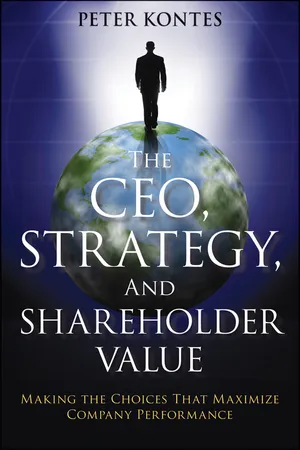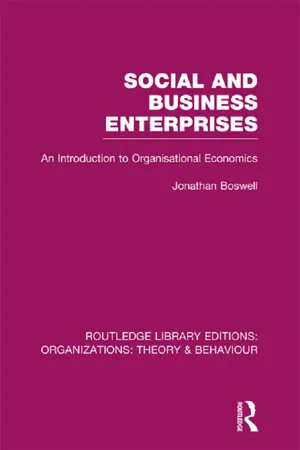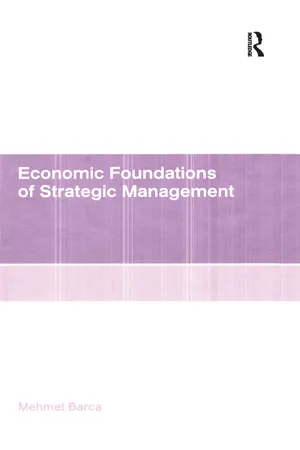Business
Economics Of Effective Management
The economics of effective management refers to the principles and strategies used to optimize resources and achieve organizational goals. It involves making efficient use of available resources, such as labor, capital, and technology, to maximize productivity and profitability. This approach emphasizes the importance of cost-benefit analysis, strategic decision-making, and effective allocation of resources to drive business success.
Written by Perlego with AI-assistance
Related key terms
3 Key excerpts on "Economics Of Effective Management"
- eBook - ePub
The CEO, Strategy, and Shareholder Value
Making the Choices That Maximize Company Performance
- Peter Kontes(Author)
- 2010(Publication Date)
- Wiley(Publisher)
CHAPTER TWOThe Economics of Strategic ManagementBUSINESS STRATEGY MUST BE about achieving concrete, measurable, and important economic objectives. Yet most of the theory and practice of business strategy lacks a sound economic foundation. The strategy literature contains strong presumptions, stated and unstated, that by pursuing certain seemingly desirable goals, such as increasing customer satisfaction or achieving economies of scale, good or improved economic results for the business will naturally follow. Unfortunately, many of these widely accepted presumptions are myths: unproven, unreliable, and often incorrect guides to good strategic decision making.The purpose of this chapter is to demonstrate the link between economic profit and strategy, to highlight some of the most common strategic myths, and to lay an economic foundation for making the best strategic management choices.ECONOMIC PROFIT
As noted in the Introduction, economic profit, or EP, is a simple concept, defined as earnings minus a charge for the equity capital employed to generate those earnings. Exhibit 2.1 shows a general example of how economic profit would be calculated for a single business unit.EXHIBIT 2.1Economic Profit (EP) CalculationBig Dog Business Unit Key Data Earnings $ 1.2 billion Equity employed $10.0 billion Cost of equity capital 10% Calculations Earnings $ 1.2 billion Capital charge –$ 1.0 billion [Capital charge: $10.0 billion ×.10] ECONOMIC PROFIT $ 200 million This economic profit calculation is the dollar amount by which the business unit’s annual earnings exceed the return on capital required by investors who assume the risk of supplying the equity used in the business. Here, investors require a minimum 10 percent return on the $10 billion of equity they have supplied, meaning there is an implicit capital charge of $1 billion the business must earn in order to truly “break even.” In this case, the business unit has earnings of $1.2 billion, or $200 million more than the minimum capital charge; therefore it is considered economically profitable. - eBook - ePub
Social and Business Enterprises (RLE: Organizations)
An Introduction to Organisational Economics
- Jonathan Boswell(Author)
- 2013(Publication Date)
- Routledge(Publisher)
Two further points need to be made about goals. First, there is the patent fact that organisations have multiple goals. Economists tend to cope with this problem in several ways. For example, in quantitative models one of an organisation's goals is regarded as dominant, with the others introduced as constraints. But in a more fundamental sense economic analysis is often precisely about the degree of consistency or ‘trade-off’ which may exist between different and often widely contrasted organisational goals. Second, the economic theory of decision making is not restricted to the dizzy heights of strategy and of dominant or overriding goals. It is also concerned with the microscopic logic of small decisions. The problem may be something as down-to-earth as appointing a foreman, scheduling meals on wheels for old people or deciding on suppliers of envelopes. Provided the decision means that scarce resources will move one way rather than another, however infinitesimally, the theory applies. But with many decisions the initial difficulty is one of correctly defining the problem. It is only when the problem has been clearly defined that an appropriate goal can be identified. That is why, in so many books on management loosely adhering to the economic approach, the first stage in decision making is specified as ‘problem formulation’. This emphasis is perfectly correct.EVALUATION OF COSTS AND BENEFITS
The third axiom of the economic theory of decision making, that the decision maker seeks to evaluate all relevant costs and benefits, poses great difficulties, both intellectual and practical. For what is the meaning of these slippery words ‘cost’ and ‘benefit’? What costs and benefits are ‘relevant’? Just those that can be quantified, or others as well? Just the costs and benefits affecting the organisation, or those affecting other people too? How do we actually perform the ‘careful evaluations’, particularly where the items we are concerned with appear to be measurable in principle but hardly in practice, measurable but not commensurable, or not even measurable at all? - eBook - ePub
- Mehmet Barca(Author)
- 2017(Publication Date)
- Routledge(Publisher)
Economics has already provided many of the building blocks upon which strategic thinking and research were constructed. Some authors go even so far as to say that ‘a minor revolution’ has been witnessed in strategic management research and writing due to the growing influence of economics (Rumelt, Schendel and Teece, 1991). Indeed, inspired by Porter in the beginning of 1980s, a new generation of strategic management scholars views economics as the base discipline for strategic thinking and research (Hirsch, Friedman, and Koza, 1990). In the last two decades, the economics and strategic management relationship has taken three forms: one group used economics for building approaches to strategy, another group critically assessed economics for identifying the kind of economics to improve existing approaches in the field, and a third group examined economics to improve the methodology of strategic inquiry. This study seeks to add another span to the theoretical bridge between strategic management and economics. In the following sections we argue that researchers working within the framework of strategic management theory need an associated theory of the firm and of the market to supply theoretical bases on which they may rely to explain their phenomena of inquiry. In this respect, the study aims to examine and assess whether economic theories of the firm and of the market provide perspectives for thinking about strategic issues and theoretical foundations for analysing significant strategic research problems.In what follows, there will be three sections. The first section explicates the purpose of the study and the way that the economics and strategic management is related and to be examined. There, the studies having hitherto dealt with the relationship between the fields of strategic management and economics are also examined in order to locate the present study within existing literature, and to explicate the need for such an initiation. The second section sets the study’s research agenda and method. The last section elucidates the organisation of the study.
Index pages curate the most relevant extracts from our library of academic textbooks. They’ve been created using an in-house natural language model (NLM), each adding context and meaning to key research topics.


